2013 PEUGEOT 3008 roof
[x] Cancel search: roofPage 4 of 352

CONTENTS
FAMILIARISATION 4-26
INSTRUMENTS and
CONTROLS 27-41CHILDSAFETY 112-123
MULTIFUNCTION
SCREENS42-55SAFETY 124-136
COMFORT 56-71
ACCESS 72-86
VISIBILITY 87-98
FITTINGS 99-111
Instrument panels 27Indicator and warning lamps 29Indicators 37Adjustment buttons 41
Child seats 112ISOFIX child seats 120Child lock 123
Screen A without audio equipment4t2Screen A with audio equipment 44Screen C (Peugeot Connect Sound (RD5))4616/9 retractable colour screen(Peugeot Connect Navigation (RT6) or Peugeot Connect Media
Navigation (NG4 3D)) 49Trip computer 52
Direction indicators 124Hazard warning lamps 124Horn 124Tyre under-inflation detection 125ESC system 126Grip control 128Front seat belts 130Airbags 133
Heating and Ventilation 56Manual air conditioning 58Rear screen demist - defrost 59Dual-zone digital air conditioning 60Front seats 63Rear seats 67Mirrors 69Steering wheel adjustment 71
Remote control key 72Alarm 77Electric windows 79Doors 81Boot 83Lower tailgate 84Fuel tank 85Misfuel prevention (Diesel) 86
Lighting controls 87LED lamps 89Automatic illumination ofheadlamps 90Headlamp adjustment 91Directional lighting 92Wiper controls 93Automatic rain sensitive wipers 95Courtesy lamps 96Interior mood lighting 97
Interior fittings 99Front armrest 101Rear multimedia 103Panoramic sunroof 105Boot fittings 106
ECO-DRIVING 25
Page 5 of 352

CONTENTS
ALPHABETICAL
INDEX 337-341
DRIVING 137-165
CHECKS 166-17
4
PRACTICAL
INFORMATION 175-206
TECHNICALDATA 207-214
AUDIO EQUIPMENT andTELEMATICS 215-336
Electric parking brake 137Hill start assist 142Head-up display 145Distance alert 147Speed limiter 149Cruise control 151Manual gearbox 153Gear shift indicator 1536-speed electronic gear control gearbox 154Automatic gearbox 158Stop & Start 161Parking sensors 164
Bonnet 167Running out of fuel (Diesel) 168Petrol engines 169Diesel engines 170Checking levels 171Checks 173
Temporary puncture repair kit 175Changing a wheel 181Changing a bulb 186Changing a fuse 19112 V battery 198Energy economy mode 201Changing a wiper blade 202
Towing the vehicle 202Towing a trailer 204Fitting roof bars 205Very cold climate screen 205Accessories 206
Petrol engines 207Petrol weights 208Diesel engines 209Diesel weights 210Dimensions 212
Identification markings 213
Emergency or assistance 215Peugeot Connect Media
Navigation (NG4 3D) 219Peugeot Connect Navigation (RT6)263Peugeot Connect Sound (RD5) 317
VISUAL
SEARCH 342-348
Page 6 of 352
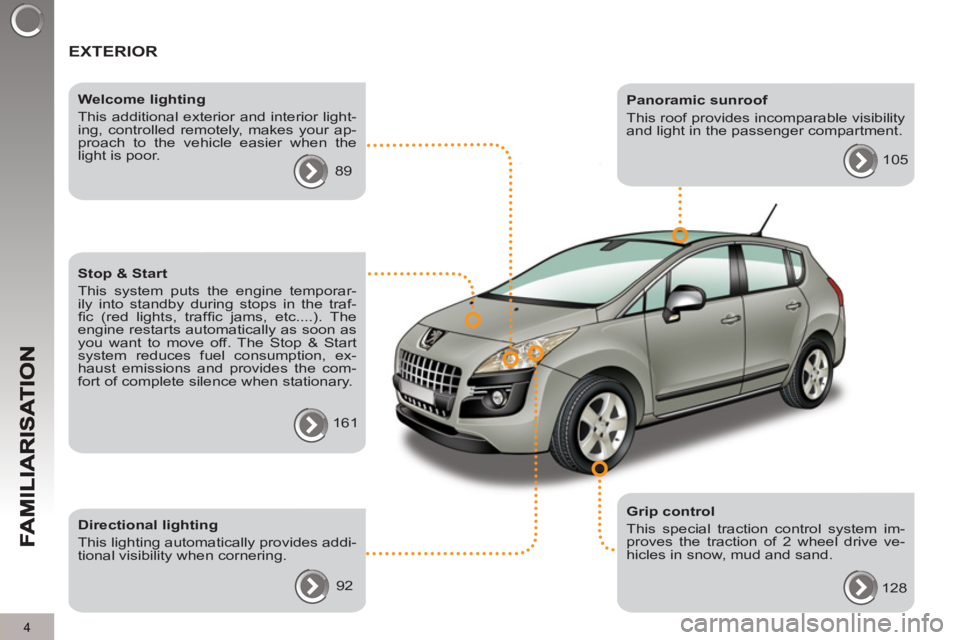
4
EXTERIOR
Grip control
This special traction control system im-
proves the traction of 2 wheel drive ve-
hicles in snow, mud and sand.
Welcome lighting
This additional exterior and interior light-
ing, controlled remotely, makes your ap-
proach to the vehicle easier when the
light is poor.
89
Directional lighting
This lighting automatically provides addi-
tional visibility when cornering.
92
Panoramic sunroof
This roof provides incomparable visibility
and light in the passenger compartment.
105
Stop & Start
This system puts the engine temporar-
ily into standby during stops in the traf-
fi c (red lights, traffi c jams, etc....). The
engine restarts automatically as soon as
you want to move off. The Stop & Start
system reduces fuel consumption, ex-
haust emissions and provides the com-
fort of complete silence when stationary.
128
161
Page 27 of 352
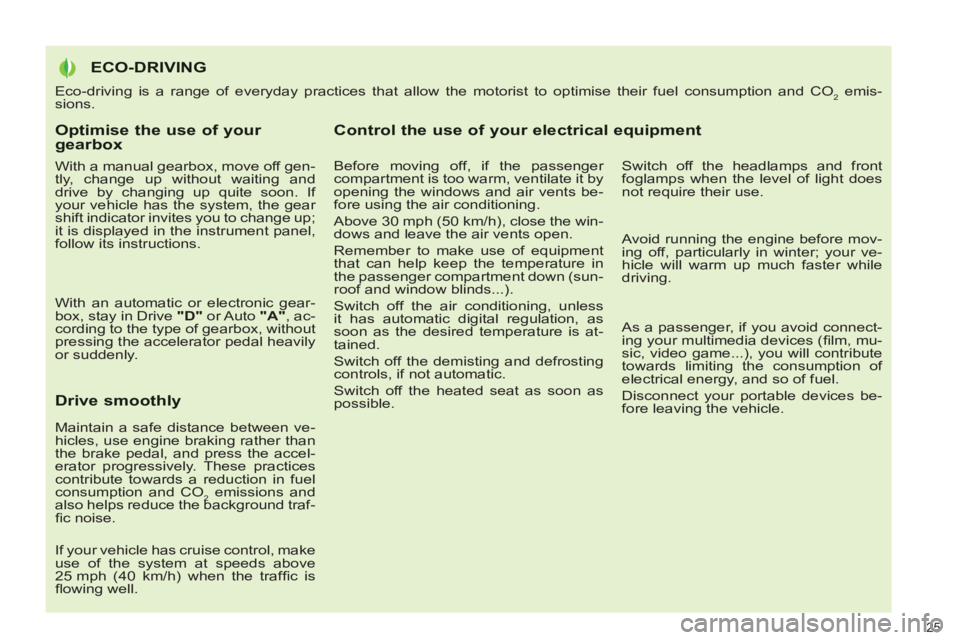
Optimise the use of your gearbox
With a manual gearbox, move off gen-
tly, change up without waiting and
drive by changing up quite soon. If
your vehicle has the system, the gear
shift indicator invites you to change up;
it is displayed in the instrument panel,
follow its instructions.
With an automatic or electronic gear-
box, stay in Drive "D"
or Auto "A"
, ac-
cording to the type of gearbox, without
pressing the accelerator pedal heavily
or suddenly.
Drive smoothly
Maintain a safe distance between ve-
hicles, use engine braking rather than
the brake pedal, and press the accel-
erator progressively. These practices
contribute towards a reduction in fuel
consumption and CO
2 emissions and
also helps reduce the background traf-
fi c noise.
If your vehicle has cruise control, make
use of the system at speeds above
25 mph (40 km/h) when the traffi c is
fl owing well.
Control the use of your electrical equipment
Before moving off, if the passenger
compartment is too warm, ventilate it by
opening the windows and air vents be-
fore using the air conditioning.
Above 30 mph (50 km/h), close the win-
dows and leave the air vents open.
Remember to make use of equipment
that can help keep the temperature in
the passenger compartment down (sun-
roof and window blinds...).
Switch off the air conditioning, unless
it has automatic digital regulation, as
soon as the desired temperature is at-
tained.
Switch off the demisting and defrosting
controls, if not automatic.
Switch off the heated seat as soon as
possible.
Switch off the headlamps and front
foglamps when the level of light does
not require their use.
Avoid running the engine before mov-
ing off, particularly in winter; your ve-
hicle will warm up much faster while
driving.
As a passenger, if you avoid connect-
ing your multimedia devices (fi lm, mu-
sic, video game...), you will contribute
towards limiting the consumption of
electrical energy, and so of fuel.
Disconnect your portable devices be-
fore leaving the vehicle.
ECO-DRIVING
25
Eco-driving is a range of everyday practices that allow the motorist to optimise their fuel consumption and CO2 emis-
sions.
Page 28 of 352
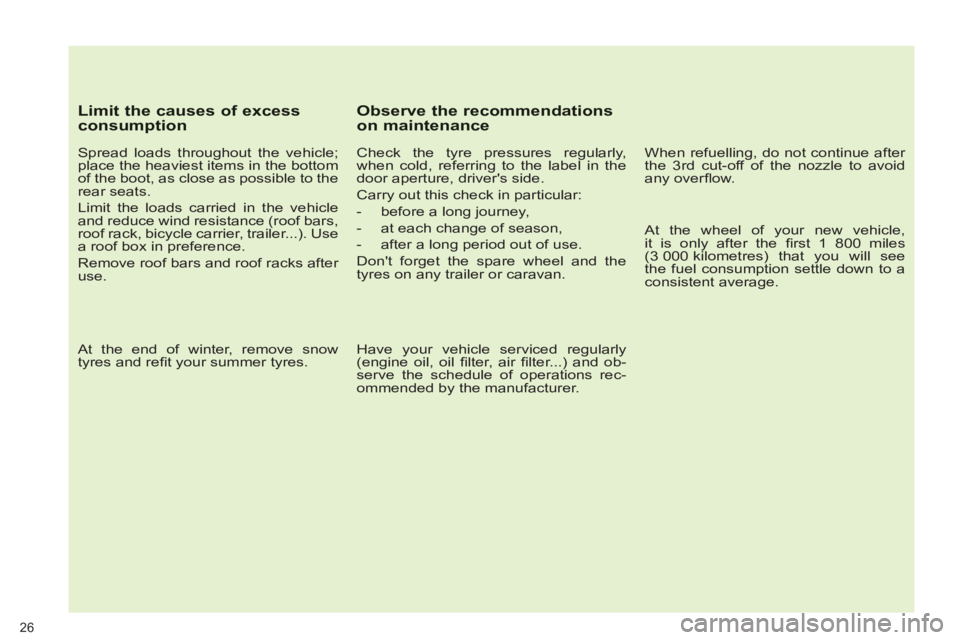
Limit the causes of excess consumption
Spread loads throughout the vehicle;
place the heaviest items in the bottom
of the boot, as close as possible to the
rear seats.
Limit the loads carried in the vehicle
and reduce wind resistance (roof bars,
roof rack, bicycle carrier, trailer...). Use
a roof box in preference.
Remove roof bars and roof racks after
use.
At the end of winter, remove snow
tyres and refi t your summer tyres.
Observe the recommendationson maintenance
Check the tyre pressures regularly,
when cold, referring to the label in the
door aperture, driver's side.
Carry out this check in particular:
- before a long journey,
- at each change of season,
- after a long period out of use.
Don't forget the spare wheel and the
tyres on any trailer or caravan.
Have your vehicle serviced regularly
(engine oil, oil fi lter, air fi lter...) and ob-
serve the schedule of operations rec-
ommended by the manufacturer.
When refuelling, do not continue after
the 3 rd cut-off of the nozzle to avoid
any overfl ow.
At the wheel of your new vehicle,
it is only after the fi rst 1 800 miles
(3 000 kilometres) that you will see
the fuel consumption settle down to a
consistent average.
26
Page 107 of 352
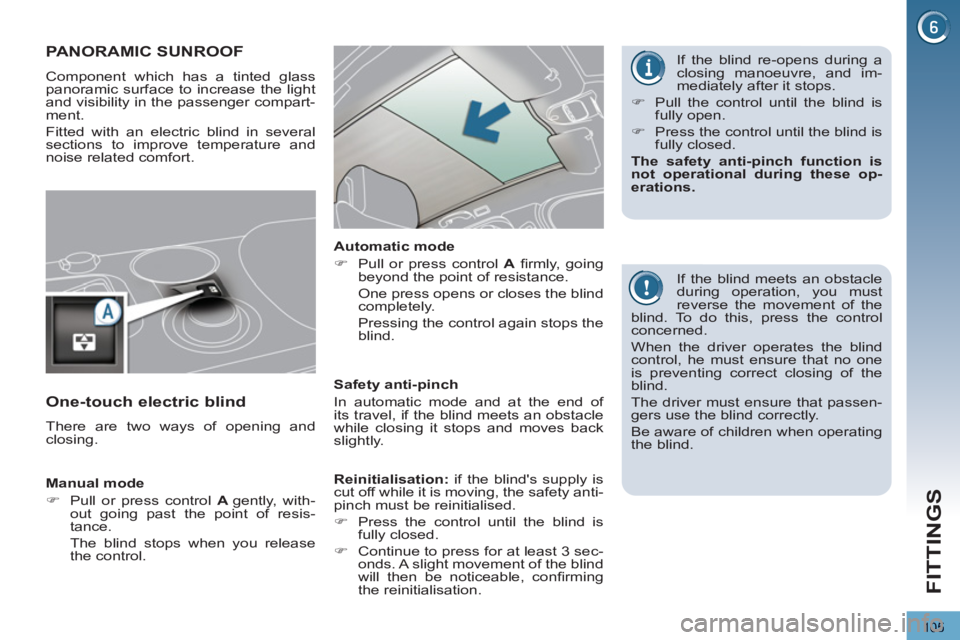
105
FITTINGS
PANORAMIC SUNROOF
Component which has a tinted glass
panoramic surface to increase the light
and visibility in the passenger compart-
ment.
Fitted with an electric blind in several
sections to improve temperature and
noise related comfort.
If the blind meets an obstacle
during operation, you must
reverse the movement of the
blind. To do this, press the control
concerned.
When the driver operates the blind
control, he must ensure that no one
is preventing correct closing of the
blind.
The driver must ensure that passen-
gers use the blind correctly.
Be aware of children when operating
the blind.
Manual mode
�)
Pull or press control A
gently, with-
out going past the point of resis-
tance.
The blind stops when you release
the control.
Automatic mode
�)
Pull or press control A
fi rmly, going
beyond the point of resistance.
One press opens or closes the blind
completely.
Pressing the control again stops the
blind.
Safety anti-pinch
In automatic mode and at the end of
its travel, if the blind meets an obstacle
while closing it stops and moves back
slightly.
One-touch electric blind
There are two ways of opening and
closing.
If the blind re-opens during a
closing manoeuvre, and im-
mediately after it stops.
�)
Pull the control until the blind is
fully open.
�)
Press the control until the blind is
fully closed.
The safety anti-pinch function is
not operational during these op-
erations.
Reinitialisation:
if the blind's supply is
cut off while it is moving, the safety anti-
pinch must be reinitialised.
�)
Press the control until the blind is
fully closed.
�)
Continue to press for at least 3 sec-
onds. A slight movement of the blind
will then be noticeable, confi rming
the reinitialisation.
Page 138 of 352
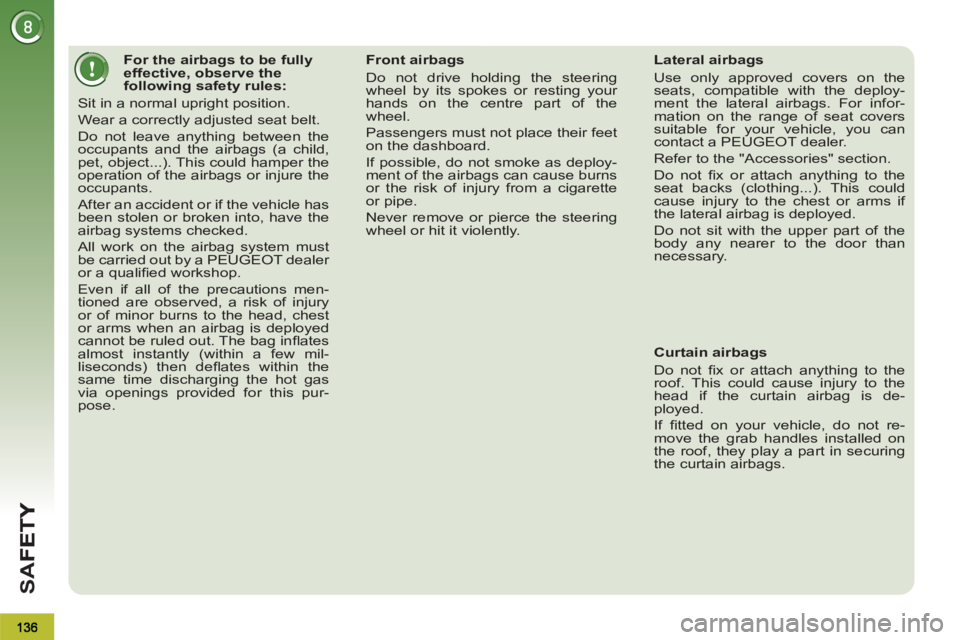
SA
F
For the airbags to be fully
effective, observe the
following safety rules:
Sit in a normal upright position.
Wear a correctly adjusted seat belt.
Do not leave anything between the
occupants and the airbags (a child,
pet, object...). This could hamper the
operation of the airbags or injure the
occupants.
After an accident or if the vehicle has
been stolen or broken into, have the
airbag systems checked.
All work on the airbag system must
be carried out by a PEUGEOT dealer
or a qualifi ed workshop.
Even if all of the precautions men-
tioned are observed, a risk of injury
or of minor burns to the head, chest
or arms when an airbag is deployed
cannot be ruled out. The bag infl ates
almost instantly (within a few mil-
liseconds) then defl ates within the
same time discharging the hot gas
via openings provided for this pur-
pose.
Front airbags
Do not drive holding the steering
wheel by its spokes or resting your
hands on the centre part of the
wheel.
Passengers must not place their feet
on the dashboard.
If possible, do not smoke as deploy-
ment of the airbags can cause burns
or the risk of injury from a cigarette
or pipe.
Never remove or pierce the steering
wheel or hit it violently.
Lateral airbags
Use only approved covers on the
seats, compatible with the deploy-
ment the lateral airbags. For infor-
mation on the range of seat covers
suitable for your vehicle, you can
contact a PEUGEOT dealer.
Refer to the "Accessories" section.
Do not fi x or attach anything to the
seat backs (clothing...). This could
cause injury to the chest or arms if
the lateral airbag is deployed.
Do not sit with the upper part of the
body any nearer to the door than
necessary.
Curtain airbags
Do not fi x or attach anything to the
roof. This could cause injury to the
head if the curtain airbag is de-
ployed.
If fi tted on your vehicle, do not re-
move the grab handles installed on
the roof, they play a part in securing
the curtain airbags.
Page 196 of 352
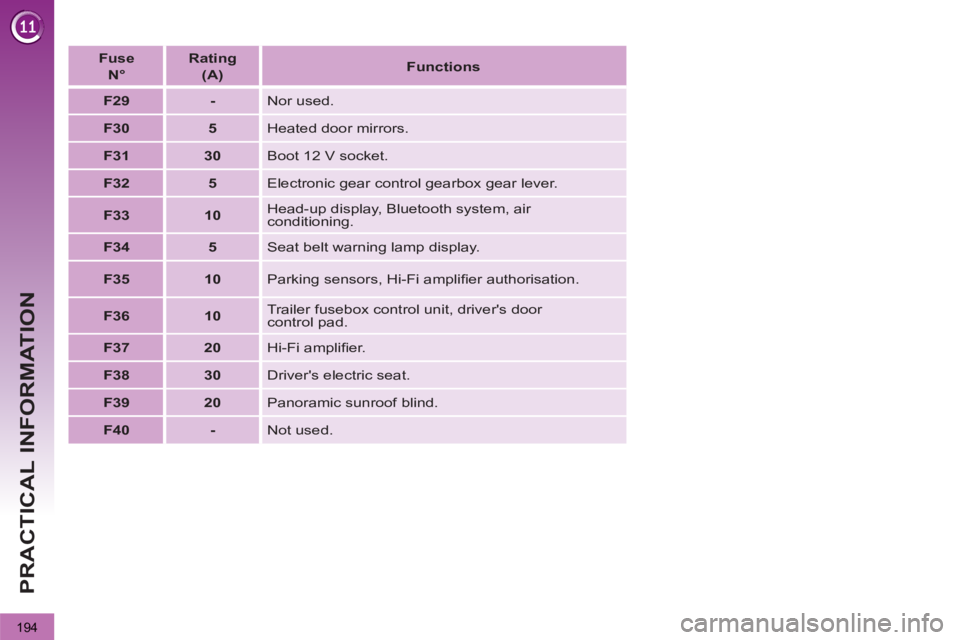
194
PRACTICAL INFORMATION
Fuse
N°
Rating
(A)
Functions
F29
-
Nor used.
F30
5
Heated door mirrors.
F31
30
Boot 12 V socket.
F32
5
Electronic gear control gearbox gear lever.
F33
10
Head-up display, Bluetooth system, air
conditioning.
F34
5
Seat belt warning lamp display.
F35
10
Parking sensors, Hi-Fi amplifi er authorisation.
F36
10
Trailer fusebox control unit, driver's door
control pad.
F37
20
Hi-Fi amplifi er.
F38
30
Driver's electric seat.
F39
20
Panoramic sunroof blind.
F40
-
Not used.